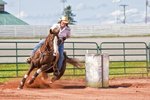Stubborn. That's the pejorative term the donkey has been saddled with. It's not really true. This particular equine species has a strong sense of self-preservation, and he's going to think things through very carefully before deciding what to do. Donkey training doesn't differ that much from horse training, but you must give your long-eared friend time to mull things over -- and never rush him.
Starting Out
Meredith Hodges, one of the country's top donkey and mule trainers, recommends imprinting the donkey foal. That refers to getting him used to you from Day One, so that your touch, scent, appearance and behavior affects his overall attitude. He also needs his mother's help with this. Hodges warns if the jenny isn't on board, she'll also need training.
Most people aren't able to start out with a donkey foal, but acquire much older animals. Even though it's somewhat more difficult with a grown donkey, the same principle applies.
Tips
While you must take training slowly with a donkey, once he learns something, he retains it, and doesn't require the frequent schooling necessary in the horse.
Haltering and Leading
When you initially halter your donkey, let him wear it for a while and get used to it. When he's fine with haltering, Hodges recommends teaching him to tie, from which he can learn to lead. She advises tying him to an appropriate post, then coming round to check on him every 10 or 15 minutes. After a while, untie him, then ask the donkey to "come." If he moves toward you, give him a treat and praise him. If he doesn't move, just retie him and try again in 10 minutes. The whole process consists of baby steps, with him learning to lead a little each day. When he is fine with leading, start taking him on walks, bringing treats to bribe -- eh, reassure -- him that any scary objects really aren't frightening.
Over time, you can start leading him through and over simple obstacle courses, such as logs, tarps, tires and the like. Again, treats can teach him to go forward or over an object if he's reluctant to pick up his feet. As he progresses, patiently teach him to back up, to halt -- that one's easy -- and to make turns.
Warnings
Hodges recommends leading training for a full year before attempting to drive or ride him. A donkey needs the time to build correct muscle strength, but the two of you also must get to know each other and build a relationship. That's key to successful donkey training.
Driving the Donkey
Before you start driving your donkey, it's crucial that he know how to reliably stand still, and that he knows verbal cues such as whoa and walk on. Expose him to carts and equines pulling them so he's not afraid. Long before he's hitched to a cart, you must teach him to ground drive, using a bridle, long reins and a driving whip to guide him -- not smack him.
Unless you're an experienced driver, it's important to have someone help you initially with harnessing your donkey and hitching him to the cart. It's vital that your harness fits properly and that your cart is the appropriate size, with shafts that fit your donkey. If you've never driven before, take some lessons before trying to drive your green donkey. Remember the old horseman's adage: "Green plus green equal black and blue."
Riding the Donkey
Donkeys come in all sizes, and if your pet is large enough, you can train him for riding. Even miniature donkeys can make good children's mount, but you need an experienced young rider to help you.
Ground driving is also essential for the riding donkey. It teaches him how to change direction, respond to cues, whoa and walk on. Before trying to mount him, find a suitable saddle and bridle and get him used to them. When you decide to mount your donkey, have someone to help you. Hodges recommends mounting and dismounting a few times initially, from both sides. If your donkey is fine with that, your helper can lead him while you sit on him. Tell your donkey to "walk on," giving him a leg squeeze cue. Carry a riding crop to lightly tap him -- not to smack him. If he goes forward even just a few steps, praise him and give him a treat. Keep sessions short. Progress with donkey training the way you would with a horse, only much slower.
Writer Bio
Jane Meggitt has been a writer for more than 20 years. In addition to reporting for a major newspaper chain, she has been published in "Horse News," "Suburban Classic," "Hoof Beats," "Equine Journal" and other publications. She has a Bachelor of Arts in English from New York University and an Associate of Arts from the American Academy of Dramatics Arts, New York City.




